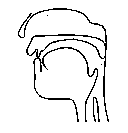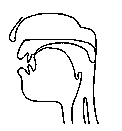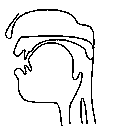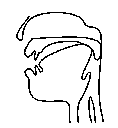Place of articulation
The active articulator usually moves in order to make the constriction.
The passive articulator usually just sits there and gets approached.
A sound's place of articulation is usually named by using the
Latin ajective for the active articulator (ending with an "o") followed by
the Latin adjective for the passive articulator. For example, a sound
where the tongue tip (the "apex") approaches or touches the upper teeth
is called an "apico-dental". Most of the common combinations of active
and passive articulator have abbreviated names (usually leaving out the
active half).
These are the abbreviated names for the places of articulation
used in English:

bilabial
The articulators are the two lips. (We could say that the lower lip is
the active articulator and the upper lip the passive articulator, though
the upper lip usually moves too, at least a little.) English bilabial
sounds include [p], [b], and [m].

labio-dental
The lower lip is the active articulator and the upper teeth are the
passive articulator. English labio-dental sounds include [f] and [v].

dental
Dental sounds involve the upper teeth as the passive articulator. The
active articulator may be either the tongue tip or (usually) the tongue
blade -- diacritic symbols can be used if it matters which. Extreme
lamino-dental sounds are often called interdental. English
interdental sounds include [ ] and [
] and [ ].
].

alveolar
Alveolar sounds involve the alveolar ridge as the passive articulator.
The active articulator may be either the tongue blade or (usually) the
tongue tip -- diacritic symbols can be used if it matters which. English
alveolar sounds include [t], [d], [n], [s], [z], [l].

postalveolar
Postalveolar sounds involve the area just behind the alveolar ridge as the
passive articulator. The active articulator may be either the tongue tip
or (usually) the tongue blade -- diacritic symbols can be used if it
matters which. English postalveolars include [ ]
and [
]
and [ ].
].
Linguists have traditionally used very inconsistent terminology in
referring to the postalveolar POA. Some of the terms you may encounter
for it include: palato-alveolar, alveo-palatal, alveolo-palatal, and even
(especially among English-speakers) palatal. Many insist that
palato-alveolar and alveo(lo)-palatal are two different things -- though
they don't agree which is which. "Postalveolar", the official term used
by the International Phonetic Association, is unambiguous, not to mention
easier to spell.

retroflex
In retroflex sounds, the tongue tip is curled up and back. Retroflexes
can be classed as apico-postalveolar, though not all apico-postalveolars
need to be curled backward enough to count as retroflex.
The closest sound to a retroflex that English has is [ ]. For most North Americans, the tongue tip is curled
back in [
]. For most North Americans, the tongue tip is curled
back in [ ], though not as much as it is in languages that have
true retroflexes. Many other North Americans use what is called a
"bunched r" -- instead of curling their tongues back, they bunch the front
up and push it forward to form an approximant behind the alveolar ridge.
], though not as much as it is in languages that have
true retroflexes. Many other North Americans use what is called a
"bunched r" -- instead of curling their tongues back, they bunch the front
up and push it forward to form an approximant behind the alveolar ridge.

palatal
The active articulator is the tongue body and the passive articulator is
the hard palate. The English glide [j] is a palatal.

velar
The active articulator is the tongue body and the passive articulator is
the soft palate. English velars include [k], [g], and [ ].
].
glottal
This isn't strictly a place of articulation, but they had to put it in the
chart somewhere. Glottal sounds are made in the larynx. For the glottal
stop, the vocal cords close momentarily and cut off all airflow through
the vocal tract. English uses the glottal stop in the interjection
uh-uh ![[?^?^]](uh-uh.gif) (meaning 'no'). In [h], the vocal cords are open, but close
enough together that air passing between them creates friction noise.
(meaning 'no'). In [h], the vocal cords are open, but close
enough together that air passing between them creates friction noise.
Note:
[w] is often called a "labio-velar". This doesn't follow the POA
naming convention -- it does not mean that the active articulator is the
lower lip and you try to touch your soft palate with it! A [w] is made up
of two different approximants: a bilabial approximant and a (dorso-)velar
approximant pronounced simultaneously.
Next: Manner of articulation
Previous: Consonant parameters
Up: table of contents







![]() ]. For most North Americans, the tongue tip is curled
back in [
]. For most North Americans, the tongue tip is curled
back in [![]() ], though not as much as it is in languages that have
true retroflexes. Many other North Americans use what is called a
"bunched r" -- instead of curling their tongues back, they bunch the front
up and push it forward to form an approximant behind the alveolar ridge.
], though not as much as it is in languages that have
true retroflexes. Many other North Americans use what is called a
"bunched r" -- instead of curling their tongues back, they bunch the front
up and push it forward to form an approximant behind the alveolar ridge.

